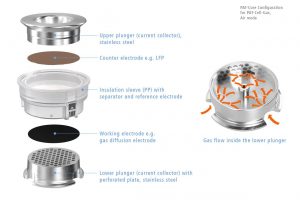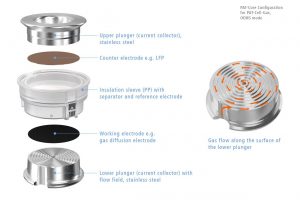For In-Situ Gas Analysis
Developed for in-situ gas analysis of battery materials in a flow-through set-up, the PAT-Cell-Gas features a gas inlet and outlet with self-locking couplings that are compatible with 1/16 in. Swagelok tube fittings. Optional built-in pressure sensor or valve port for gas sampling with a syringe are also available.
The PAT-Cell-Gas combines all capabilities of the ECC-Air, ECC-DEMS and PAT-Cell-Press test cells.
The cell stack is placed on top of a perforated or grooved current collector (flow field), which is to be purged with a gentle stream of gas. The lower electrode must be gas permeable, so as to allow for gas exchange with the feed gas. Typically, the cell is used with gas diffusion electrodes (such as for Li-air) or with Li-ion battery electrodes with a meshed current collector. This special design minimizes backmixing of the gas from the flowfield back into the headspace, and is thus very suitable for time-resolved gas analysis with a mass spectrometer, for example.
All PAT-Cell-Gas variants can be operated directly with the PAT-Tester-x potentiostat. If used with a 3rd party potentiostat, the PAT-Press-Box is required for all variants equipped with a pressure sensor.




